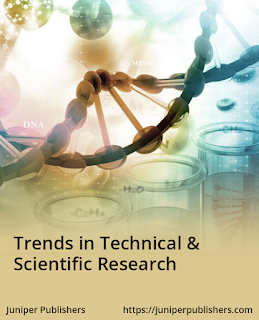Common Drug Interactions that Affect Therapeutic Efficacy - Juniper publishers
Journal of Trends in Technical and Scientific Research
Keywords: Drug; Therapeutic efficacy; Absorption; Metabolism; Pharmacokinetic and pharmacodynamic
Ever wondered why certain medications prescribed by
medical experts fail to deliver therapeutically? With billions of drug
prescriptions filled in each year, it is imperative for drug users to
know about drug interactions that can result in loss of efficacy and
adverse drug reactions in order to avoid problems. This short commentary
is to respond to the educative needs of drug users on the implications
of common food-drug combinations. This article will address the
appropriateness of food-drug combinations with respect to dose and
timing. Literature abound to support claims for the interactions between
bioactive constituents of food and drugs. These interactions may occurs
in at least one of the following phases namely: absorption, metabolism,
pharmacokinetic and pharmacodynamic stage [1].
Food-drug interaction results from the unique physical, chemical and
physiological relationship between a drug and food consumed for the sole
aim of harnessing nutrients. Dietary components can increase or
decrease drug exposure increasing the risk of toxicity (adverse drug
reactions) of loss of drug efficacy respectively. This happens through
mechanisms which have physiologic, physicochemical and biochemical
undertones [2].
Now we look at common, specific cases 'close-to-home'
of food-drug interactions, drug action and how they are affected by the
factors [1,2] named above.
Efficacy of antibiotics is affected by Ca2+ rich food (s): Such as tetracyclins and flouroquinolines can bind to divalent cations such as Ca2+
present in dairy products leading to reduced drug absorption and loss
of drug efficacy. Several mechanisms have been suggested for this
outcome however, the most plausible is competitive antagonism between Ca2+ and the antibiotics. This results from the affinity of the two for same carrier and binding site.
Fatty meals increase absorption of lipophilic drugs:
As opposed to '1' above, fatty meals increase the absorption of
lipophilic drugs leading to increased drug exposure and toxicity. In
many parts of the 'third world' where animal fat is used for frying as
an alternative to plant oils may be at risk not only of cardiovascular
diseases but also fat-lipophilic drug- interaction toxicity.
Carbonated soft drinks enhance absorption of painkillers:
Some individuals swallow drugs with carbonated drinks in order mask the
unappealing taste of drugs. Analogous to '2' above, addition of CO2
to soft drinks under pressure results to the formation of carbonic acid
hence making the solution acidic. Carbonic acid though a weak acid
increases the bioavailability of painkillers in the blood above
therapeutic thresholds which leads to toxicity [3].
Caffeine present in some soft drinks and caffeine also enhance the
absorption of drugs especially painkillers and antipsychotics. More
recently, drug abusers consume tramadol an opoid pain medication in
solution of soft drinks. This combination is capable of rapid absorption
hence reaching a very high serum concentration in short time.
K+ rich leafy vegetables interferes with anti-coagulant drugs: Leafy vegetables are rich in Fe2+ and cofactors such as K+
important for the blood clotting biochemical pathway. By implication
consumption of leafy vegetables equips the body for quick recoveries
from open wounds. However, in certain disease states such as heart
diseases were blot clot is a risk factor, anti-coagulant drugs e.g
aspirin and warfarin are administered. K+rich leafy vegetables e.g.
spinach interferes with these blood thinning anti-coagulants hence
leading to increased formation of clots. Note however, that consumption
of moderate amounts of leafy vegetables may not be detrimental in
individual receiving warfarin treatment.
Alcohol enhances drug toxicity: It is common
knowledge that poisons act faster when consumed with alcohol. In fact,
this may be the motivation to 'spike' alcoholic drinks with date rape
drugs. The reason for this is not farfetched. Alcohol is metabolized by
the Cytochrome P450 which is incidentally responsible for general drug
metabolism [4].
It has been demonstrated through experiments that alcohol increases
expression and activity of many isozymes of Cytochrome P450. This drug
metabolism is required for activation of drug compounds into their
active forms which could be either detrimental or therapeutic.
Administration of a potentially toxic drug with alcohol enhance the rate
of formation of the active species and severity of toxicity.
Vitamin C diminishes efficacy of anti-malarial drugs:
Malaria parasite requires Iron present in blood for survival. Vitamin C
(present in orange, grape, other common fruits and as tablets) often
co-administered with anti-malarial drugs such as artemisinin and its
derivatives is both an anti-oxidant and enhancer of Iron uptake by the
liver. Paradoxically, artemisinin based anti-malarial drugs elicit their
therapeutic effects via a pathway that involves production of
anti-plasmodial oxidative derivatives by a Fenton's reaction [5].
These derivatives are oxidative radicals that can be scavenged by
Vitamin C hence neutralising the effect of the artemisinin intervention.
The knowledge of how foods may interact with drugs
are of great benefit to drug users. Tremendous amount of effort has gone
into understanding the mechanisms underlying the food- drug
interactions however, since they are no standard models
for predicting food drug interactions our understanding of the
matter is experiential. It is therefore necessary for drug users to bear
in mind the following questions:
To Know More About Trends in Technical and
ScientificResearch Please click on:
https://juniperpublishers.com/ttsr/index.php
To Know More About Open Access Journals Please click on:



Comments
Post a Comment